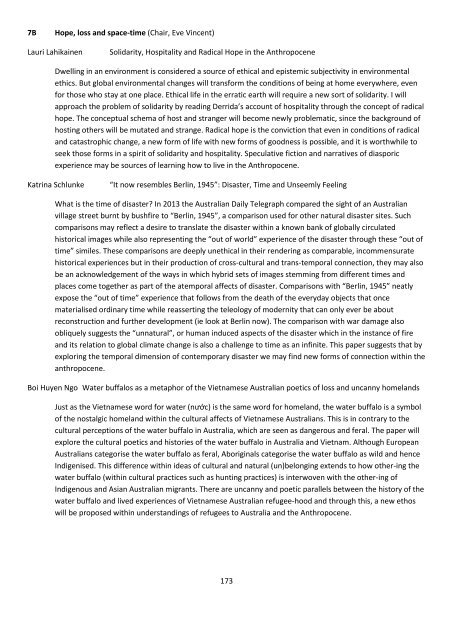Crossroads in Cultural Studies Conference 14-17th December 2016 Program Index
Crossroads-2016-final-draft-program-30-Nov
Crossroads-2016-final-draft-program-30-Nov
You also want an ePaper? Increase the reach of your titles
YUMPU automatically turns print PDFs into web optimized ePapers that Google loves.
7B<br />
Hope, loss and space-time (Chair, Eve V<strong>in</strong>cent)<br />
Lauri Lahika<strong>in</strong>en<br />
Solidarity, Hospitality and Radical Hope <strong>in</strong> the Anthropocene<br />
Dwell<strong>in</strong>g <strong>in</strong> an environment is considered a source of ethical and epistemic subjectivity <strong>in</strong> environmental<br />
ethics. But global environmental changes will transform the conditions of be<strong>in</strong>g at home everywhere, even<br />
for those who stay at one place. Ethical life <strong>in</strong> the erratic earth will require a new sort of solidarity. I will<br />
approach the problem of solidarity by read<strong>in</strong>g Derrida’s account of hospitality through the concept of radical<br />
hope. The conceptual schema of host and stranger will become newly problematic, s<strong>in</strong>ce the background of<br />
host<strong>in</strong>g others will be mutated and strange. Radical hope is the conviction that even <strong>in</strong> conditions of radical<br />
and catastrophic change, a new form of life with new forms of goodness is possible, and it is worthwhile to<br />
seek those forms <strong>in</strong> a spirit of solidarity and hospitality. Speculative fiction and narratives of diasporic<br />
experience may be sources of learn<strong>in</strong>g how to live <strong>in</strong> the Anthropocene.<br />
Katr<strong>in</strong>a Schlunke<br />
“It now resembles Berl<strong>in</strong>, 1945”: Disaster, Time and Unseemly Feel<strong>in</strong>g<br />
What is the time of disaster? In 2013 the Australian Daily Telegraph compared the sight of an Australian<br />
village street burnt by bushfire to “Berl<strong>in</strong>, 1945”, a comparison used for other natural disaster sites. Such<br />
comparisons may reflect a desire to translate the disaster with<strong>in</strong> a known bank of globally circulated<br />
historical images while also represent<strong>in</strong>g the “out of world” experience of the disaster through these “out of<br />
time” similes. These comparisons are deeply unethical <strong>in</strong> their render<strong>in</strong>g as comparable, <strong>in</strong>commensurate<br />
historical experiences but <strong>in</strong> their production of cross-cultural and trans-temporal connection, they may also<br />
be an acknowledgement of the ways <strong>in</strong> which hybrid sets of images stemm<strong>in</strong>g from different times and<br />
places come together as part of the atemporal affects of disaster. Comparisons with “Berl<strong>in</strong>, 1945” neatly<br />
expose the “out of time” experience that follows from the death of the everyday objects that once<br />
materialised ord<strong>in</strong>ary time while reassert<strong>in</strong>g the teleology of modernity that can only ever be about<br />
reconstruction and further development (ie look at Berl<strong>in</strong> now). The comparison with war damage also<br />
obliquely suggests the “unnatural”, or human <strong>in</strong>duced aspects of the disaster which <strong>in</strong> the <strong>in</strong>stance of fire<br />
and its relation to global climate change is also a challenge to time as an <strong>in</strong>f<strong>in</strong>ite. This paper suggests that by<br />
explor<strong>in</strong>g the temporal dimension of contemporary disaster we may f<strong>in</strong>d new forms of connection with<strong>in</strong> the<br />
anthropocene.<br />
Boi Huyen Ngo Water buffalos as a metaphor of the Vietnamese Australian poetics of loss and uncanny homelands<br />
Just as the Vietnamese word for water (nước) is the same word for homeland, the water buffalo is a symbol<br />
of the nostalgic homeland with<strong>in</strong> the cultural affects of Vietnamese Australians. This is <strong>in</strong> contrary to the<br />
cultural perceptions of the water buffalo <strong>in</strong> Australia, which are seen as dangerous and feral. The paper will<br />
explore the cultural poetics and histories of the water buffalo <strong>in</strong> Australia and Vietnam. Although European<br />
Australians categorise the water buffalo as feral, Aborig<strong>in</strong>als categorise the water buffalo as wild and hence<br />
Indigenised. This difference with<strong>in</strong> ideas of cultural and natural (un)belong<strong>in</strong>g extends to how other-<strong>in</strong>g the<br />
water buffalo (with<strong>in</strong> cultural practices such as hunt<strong>in</strong>g practices) is <strong>in</strong>terwoven with the other-<strong>in</strong>g of<br />
Indigenous and Asian Australian migrants. There are uncanny and poetic parallels between the history of the<br />
water buffalo and lived experiences of Vietnamese Australian refugee-hood and through this, a new ethos<br />
will be proposed with<strong>in</strong> understand<strong>in</strong>gs of refugees to Australia and the Anthropocene.<br />
173


